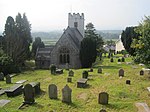Lleweni Hall
Gardens by Capability BrownHouses in DenbighshireSalusbury familyTremeirchionUse British English from July 2022

Lleweni Hall (Welsh: Plas Lleweni; sometimes also referred to as Llewenny Palace) was a stately home in Denbighshire, northeast Wales, around 2 miles (3.2 km) north-east of Denbigh on the banks of the River Clwyd. It was the principal seat of the Salusbury family and their descendants from 1289 until 1748, and the present territorial designation of the most senior branch of the family.
Excerpt from the Wikipedia article Lleweni Hall (License: CC BY-SA 3.0, Authors, Images).Lleweni Hall
A541,
Geographical coordinates (GPS) Address External links Nearby Places Show on map
Geographical coordinates (GPS)
| Latitude | Longitude |
|---|---|
| N 53.2057 ° | E -3.3759 ° |
Address
A541
LL16 4BW , Bodfari
Wales, United Kingdom
Open on Google Maps









